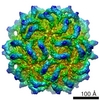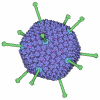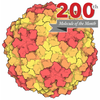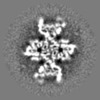[English] 日本語
 Yorodumi
Yorodumi- EMDB-1178: Structure of the dodecahedral penton particle from human adenovir... -
+ Open data
Open data
- Basic information
Basic information
| Entry | Database: EMDB / ID: EMD-1178 | |||||||||
|---|---|---|---|---|---|---|---|---|---|---|
| Title | Structure of the dodecahedral penton particle from human adenovirus type 3. | |||||||||
 Map data Map data | The pixel size has been calibrated using the X-ray structure of adenovirus 2 penton base. Accession number 1X9P | |||||||||
 Sample Sample |
| |||||||||
| Function / homology |  Function and homology information Function and homology informationT=25 icosahedral viral capsid / adhesion receptor-mediated virion attachment to host cell / viral capsid / clathrin-dependent endocytosis of virus by host cell / cell adhesion / symbiont entry into host cell / host cell nucleus / virion attachment to host cell / structural molecule activity Similarity search - Function | |||||||||
| Biological species |  Human adenovirus 3 Human adenovirus 3 | |||||||||
| Method | single particle reconstruction / cryo EM / negative staining / Resolution: 9.3 Å | |||||||||
 Authors Authors | Fuschiotti P / Schoehn G / Fender P / Fabry CMS / Hewat EA / Chroboczek J | |||||||||
 Citation Citation |  Journal: J Mol Biol / Year: 2006 Journal: J Mol Biol / Year: 2006Title: Structure of the dodecahedral penton particle from human adenovirus type 3. Authors: P Fuschiotti / G Schoehn / P Fender / C M S Fabry / E A Hewat / J Chroboczek / R W H Ruigrok / J F Conway /  Abstract: The sub-viral dodecahedral particle of human adenovirus type 3, composed of the viral penton base and fiber proteins, shares an important characteristic of the entire virus: it can attach to cells ...The sub-viral dodecahedral particle of human adenovirus type 3, composed of the viral penton base and fiber proteins, shares an important characteristic of the entire virus: it can attach to cells and penetrate them. Structure determination of the fiberless dodecahedron by cryo-electron microscopy to 9 Angstroms resolution reveals tightly bound pentamer subunits, with only minimal interfaces between penton bases stabilizing the fragile dodecahedron. The internal cavity of the dodecahedron is approximately 80 Angstroms in diameter, and the interior surface is accessible to solvent through perforations of approximately 20 Angstroms diameter between the pentamer towers. We observe weak density beneath pentamers that we attribute to a penton base peptide including residues 38-48. The intact amino-terminal domain appears to interfere with pentamer-pentamer interactions and its absence by mutation or proteolysis is essential for dodecamer assembly. Differences between the 9 Angstroms dodecahedron structure and the adenovirus serotype 2 (Ad2) crystallographic model correlate closely with differences in sequence. The 3D structure of the dodecahedron including fibers at 16 Angstroms resolution reveals extra density on the top of the penton base that can be attributed to the fiber N terminus. The fiber itself exhibits striations that correlate with features of the atomic structure of the partial Ad2 fiber and that represent a repeat motif present in the amino acid sequence. These new observations offer important insights into particle assembly and stability, as well as the practicality of using the dodecahedron in targeted drug delivery. The structural work provides a sound basis for manipulating the properties of this particle and thereby enhancing its value for such therapeutic use. | |||||||||
| History |
|
- Structure visualization
Structure visualization
| Movie |
 Movie viewer Movie viewer |
|---|---|
| Structure viewer | EM map:  SurfView SurfView Molmil Molmil Jmol/JSmol Jmol/JSmol |
| Supplemental images |
- Downloads & links
Downloads & links
-EMDB archive
| Map data |  emd_1178.map.gz emd_1178.map.gz | 12.4 MB |  EMDB map data format EMDB map data format | |
|---|---|---|---|---|
| Header (meta data) |  emd-1178-v30.xml emd-1178-v30.xml emd-1178.xml emd-1178.xml | 10.1 KB 10.1 KB | Display Display |  EMDB header EMDB header |
| Images |  1178.gif 1178.gif | 31 KB | ||
| Archive directory |  http://ftp.pdbj.org/pub/emdb/structures/EMD-1178 http://ftp.pdbj.org/pub/emdb/structures/EMD-1178 ftp://ftp.pdbj.org/pub/emdb/structures/EMD-1178 ftp://ftp.pdbj.org/pub/emdb/structures/EMD-1178 | HTTPS FTP |
-Validation report
| Summary document |  emd_1178_validation.pdf.gz emd_1178_validation.pdf.gz | 267.6 KB | Display |  EMDB validaton report EMDB validaton report |
|---|---|---|---|---|
| Full document |  emd_1178_full_validation.pdf.gz emd_1178_full_validation.pdf.gz | 266.7 KB | Display | |
| Data in XML |  emd_1178_validation.xml.gz emd_1178_validation.xml.gz | 11.8 KB | Display | |
| Arichive directory |  https://ftp.pdbj.org/pub/emdb/validation_reports/EMD-1178 https://ftp.pdbj.org/pub/emdb/validation_reports/EMD-1178 ftp://ftp.pdbj.org/pub/emdb/validation_reports/EMD-1178 ftp://ftp.pdbj.org/pub/emdb/validation_reports/EMD-1178 | HTTPS FTP |
-Related structure data
- Links
Links
| EMDB pages |  EMDB (EBI/PDBe) / EMDB (EBI/PDBe) /  EMDataResource EMDataResource |
|---|---|
| Related items in Molecule of the Month |
- Map
Map
| File |  Download / File: emd_1178.map.gz / Format: CCP4 / Size: 40.5 MB / Type: IMAGE STORED AS SIGNED INTEGER (2 BYTES) Download / File: emd_1178.map.gz / Format: CCP4 / Size: 40.5 MB / Type: IMAGE STORED AS SIGNED INTEGER (2 BYTES) | ||||||||||||||||||||||||||||||||||||||||||||||||||||||||||||||||||||
|---|---|---|---|---|---|---|---|---|---|---|---|---|---|---|---|---|---|---|---|---|---|---|---|---|---|---|---|---|---|---|---|---|---|---|---|---|---|---|---|---|---|---|---|---|---|---|---|---|---|---|---|---|---|---|---|---|---|---|---|---|---|---|---|---|---|---|---|---|---|
| Annotation | The pixel size has been calibrated using the X-ray structure of adenovirus 2 penton base. Accession number 1X9P | ||||||||||||||||||||||||||||||||||||||||||||||||||||||||||||||||||||
| Projections & slices | Image control
Images are generated by Spider. | ||||||||||||||||||||||||||||||||||||||||||||||||||||||||||||||||||||
| Voxel size | X=Y=Z: 1.37 Å | ||||||||||||||||||||||||||||||||||||||||||||||||||||||||||||||||||||
| Density |
| ||||||||||||||||||||||||||||||||||||||||||||||||||||||||||||||||||||
| Symmetry | Space group: 1 | ||||||||||||||||||||||||||||||||||||||||||||||||||||||||||||||||||||
| Details | EMDB XML:
CCP4 map header:
| ||||||||||||||||||||||||||||||||||||||||||||||||||||||||||||||||||||
-Supplemental data
- Sample components
Sample components
-Entire : adenovirus 3 penton base dodecahedron
| Entire | Name: adenovirus 3 penton base dodecahedron |
|---|---|
| Components |
|
-Supramolecule #1000: adenovirus 3 penton base dodecahedron
| Supramolecule | Name: adenovirus 3 penton base dodecahedron / type: sample / ID: 1000 Details: The penton base was expressed in baculovirus abd the penton base self-assemble into dodecahedrons Oligomeric state: 12 pentamers / Number unique components: 1 |
|---|---|
| Molecular weight | Experimental: 3.5 MDa |
-Macromolecule #1: Ad3 penton base
| Macromolecule | Name: Ad3 penton base / type: protein_or_peptide / ID: 1 / Number of copies: 60 / Oligomeric state: dodecamer of pentamer / Recombinant expression: Yes |
|---|---|
| Source (natural) | Organism:  Human adenovirus 3 / synonym: human adenovirus 3 Human adenovirus 3 / synonym: human adenovirus 3 |
| Molecular weight | Experimental: 60 KDa / Theoretical: 60 KDa |
| Recombinant expression | Organism:  unidentified baculovirus / Recombinant plasmid: pAcUW31 unidentified baculovirus / Recombinant plasmid: pAcUW31 |
-Experimental details
-Structure determination
| Method | negative staining, cryo EM |
|---|---|
 Processing Processing | single particle reconstruction |
| Aggregation state | particle |
- Sample preparation
Sample preparation
| Concentration | 1 mg/mL |
|---|---|
| Buffer | pH: 6.6 / Details: 25 mM phosphate buffer at pH 6.6 |
| Staining | Type: NEGATIVE Details: Quantifoil R2 1 grids (Quantifoil Micro Tools GmbH, Germany) were loaded with 4 ul of sample at 1 mg ml, blotted and rapidly frozen in liquid ethane within a liquid nitrogen bath using a Zeiss cryoplunger |
| Grid | Details: Quantifoil R2/1 grids |
| Vitrification | Cryogen name: ETHANE / Chamber temperature: 100 K / Instrument: OTHER / Details: Vitrification instrument: Zeiss cryoplunger |
- Electron microscopy
Electron microscopy
| Microscope | JEOL 2010F |
|---|---|
| Temperature | Average: 100 K |
| Alignment procedure | Legacy - Astigmatism: objective lens astigmatism was corrected at 100,000 |
| Image recording | Category: FILM / Film or detector model: KODAK SO-163 FILM / Digitization - Scanner: ZEISS SCAI / Digitization - Sampling interval: 7 µm / Number real images: 14 |
| Electron beam | Acceleration voltage: 200 kV / Electron source:  FIELD EMISSION GUN FIELD EMISSION GUN |
| Electron optics | Calibrated magnification: 51100 / Illumination mode: OTHER / Imaging mode: BRIGHT FIELD / Cs: 1.4 mm / Nominal defocus max: 2.5 µm / Nominal defocus min: 1.0 µm / Nominal magnification: 50000 |
| Sample stage | Specimen holder: Eucentric / Specimen holder model: OTHER |
- Image processing
Image processing
| Details | The particles were selected using X3d |
|---|---|
| CTF correction | Details: each negative or each focal pair |
| Final reconstruction | Applied symmetry - Point group: I (icosahedral) / Algorithm: OTHER / Resolution.type: BY AUTHOR / Resolution: 9.3 Å / Resolution method: FSC 0.33 CUT-OFF / Software - Name: PFT EM3DR PFT2 EM3DR2 / Number images used: 1849 |
 Movie
Movie Controller
Controller













 Z (Sec.)
Z (Sec.) Y (Row.)
Y (Row.) X (Col.)
X (Col.)





















